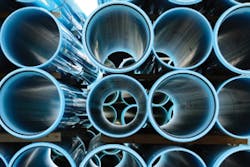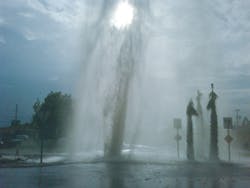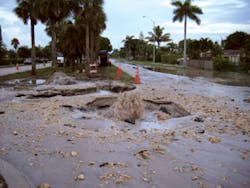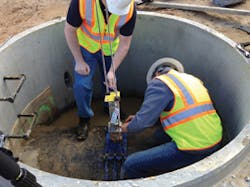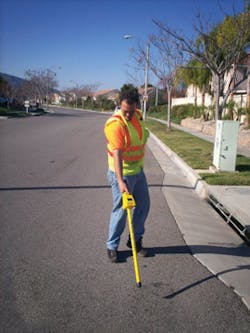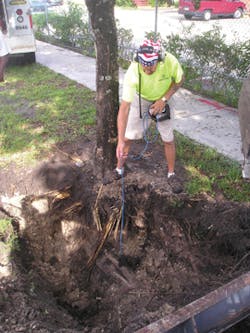Once again, the nation’s infrastructure report card is out. And once again, it shows no sign of improvement. The American Society of Civil Engineers (ASCE) gives America’s drinking water infrastructure a D.
Much of the nation’s drinking water infrastructure is nearing the end of its useful life, the ASCE reports, adding there are an annual estimated 240,000 water main breaks.
The cost in ensuing decades to replace every pipe could top $1 trillion, according to the American Water Works Association (AWWA). The bright side: although pipes and mains are aged and need replacement, outbreaks of disease attributable to drinking water are rare.
When Rob Meston, president of Utility Services Associates, first got into the leak detection business in 1990, water conservation was near the bottom of the list of concerns.
“Now it’s at the top of everybody’s list,” he says. “Seattle is a great example. They’ve had to figure out a way to conserve water. What that means to the utilities is less revenue. These utilities have become much more efficient and have had to operate with much tighter conservation measures in place, when in fact that’s what they’re selling—water is their product.”
Once again, the nation's infrastructure report card is out. And once again, it shows no sign of improvement. The American Society of Civil Engineers (ASCE) gives America's drinking water infrastructure a D. Much of the nation's drinking water infrastructure is nearing the end of its useful life, the ASCE reports, adding there are an annual estimated 240,000 water main breaks. The cost in ensuing decades to replace every pipe could top $1 trillion, according to the American Water Works Association (AWWA). The bright side: although pipes and mains are aged and need replacement, outbreaks of disease attributable to drinking water are rare. [caption id="attachment_1364" align="alignleft" width="270"]More utilities are turning to water audits and leak detection to help identify non-revenue water losses in systems.
Mark Patience, Itron’s product manager for water loss management, points out that many water utilities worldwide have an entire non-revenue water department, but it’s not prevalent in the US.
But now, “we’re seeing a lot more attention paid to non-revenue water by utilities,” says Patience, adding he’s observed an increased interest over the past few years in utilities addressing non-revenue water.
“Before, it was just a number; they didn’t really care about it, and nobody really monitored it,” he says. “Now some states are getting really aggressive in having their utilities report their non-revenue water, and report that accurately. We’re seeing a lot more cases where, instead of us trying to show utilities why non-revenue water is important, there are more utilities asking us to help them get a non-revenue water program going.”
The cost in ensuing decades to replace every pipe could top $1 trillion.
Preparing for an Audit
It’s important to understand the terms that define utility resources. Water supply—”water supplied”—is defined as encompassing local resources under the utility’s management, as well as water imported from other locations.
Water supplied is defined as encompassing a utility’s own water sources and imported water. “Billed water”—which is exported through transfer meters—includes billed and unbilled authorized consumption, along with apparent and real water losses. Billed authorized consumption includes billed metered consumption and billed flat rate usage via unmetered consumption of revenue water. Unbilled authorized consumption includes unbilled metered consumption at public facilities and unbilled unmetered consumption of non-revenue water at unbilled meter use and lost accounts.
Apparent losses also are part of non-revenue water, and include unauthorized consumption through theft, customer-metering inaccuracies through inaccurate or misapplied meters, and systematic data handling errors through wrong billing multiples. Real losses include leakage on distribution mains, service lines, and leakage and overflows at storage.
Russell Titus, operations supervisor for water loss management for New Jersey American Water, says there are two drivers for water systems to prepare water audits: internal strategy and regulatory pressure.
“It is important that the preparation of a proper water audit be the first step in reviewing a water system’s losses,” says Titus. “This is because water losses are assessed into two categories: apparent and real losses. Apparent losses are typically losses due to inaccurate metering or billing, whereas real losses represent an actual loss of product from the system unrelated to a sale, whether intention or unintentional. If real losses represent a financial liability to the system, one of ways to mitigate the issue is through active leakage control using some form of leak detection.”
Titus says water systems have four avenues to approach mitigating real losses: pressure management, speed of repairs, replacement and rehabilitation of network piping and active leak control.
“Each water system needs to evaluate the risk associated with each of these areas and make an evaluation of the cost versus the potential return,” he says. “Systems with old infrastructure typically include some element of leak detection, which often incorporates devices like noise loggers, correlating loggers and listening sticks.”
A water system’s proper operation is somewhat “agnostic” to funding issues as a result of the current economy, says Titus. “System operators are stewards of their water, from supply to delivery, and typically have long-term plans to address deterioration of the infrastructure,” he says. “A proper water audit is an essential tool in calculating the economic impact of water losses.”
Titus points out that the value of one 50-gallon per minute leak running for one year is equal to the price of a leak correlator, as is digging one hole instead of five to find a leak.
“Given time, leaks develop on all parts of water systems: transmission and distribution mains, hydrants, valves, and service lines,” he says.
Guidance on water audit preparation and leak detection surveying can be derived from several sources, including the AWWA, EPA, the United States Department of Agriculture Rural Community Assistance Program, and the National Rural Water Association, Titus points out.
Conducting an Audit
In Chandler, AZ, water audits are conducted on two fronts.
“If a customer suspects they have high water use, we would go to the Neptune meter which has data logging and it shows us what they used,” says Jim Crocker, business manager for the city’s utilities service.
The information is broken down to the day and hour and is maintained for about 90 days, Crocker notes. His department also is able to view graphics that show when the spike in water use occurred.
“Usually that leads to a discussion with a customer, and they say ‘Oh yeah, I did fill my pool’, or ‘no way’, and they can start in a direction to find out where their leaks are,” he says. “We tell them to isolate the landscape system by shutting it off. We tell them how to read the meters so they can get daily reads; by the time they’ve done that, the end result is usually the pool or a running toilet.”
Data logging has been helpful in mitigating what used to be a problem with water loss that could pit the property owner against the utility, Crocker says. The utility serves about 80,000 property owners, mostly residential, as well as a few large industrial users. The city also does an audit of the overall city water use, tracking how much is delivered and how much is billed, with the difference being non-revenue water.
In arid states, such as Arizona, that cannot afford water losses, water efficiency is critical, Crocker says.
“That’s part of the importance of bringing in accurate meters so that what you’re billing is accurate,” he says, adding that in Arizona, there cannot be more than 10% non-revenue water. “Since we installed the Neptune meters, we’ve found much better accuracy on what is being billed.”
Chandler engages in a lot of reclaimed water activities and sells reclaimed water for landscape use, Crocker adds. “We are very conscious of the amount of water we use. We are now at 60% automatic meters. We don’t have to stop to read them. We just drive down the street, and it picks up the read.”
The program initially began in 2001. The utility was entering into a new billing system.
“At the time, we had inexpensive meters, but their quality was very poor, and they were about 30 years old,” says Crocker. “We went to a newer technology while we made the switch.”
In 2007, the city engaged in a large replacement effort, switching out 27,000 meters. Crocker says he feels for utilities trying to address the issue of water loss in a time when the economy presents challenges in funding such operations.
“We were pretty fortunate in that just before the recession really got heavy, we did that large replacement program,” he says. “Even though we were a little bit into the recession, we put the money aside and got a big chunk of those meters out of there.”
During the recession, the utility has continually replaced meters that aren’t working, about 3,000 meters annually.
“Hopefully over the next few years as the economy starts to come back a little bit, the city can get a little more aggressive on that replacement program and get the rest of them out of there,” says Crocker.
The city chose Neptune after an extensive Request For Proposal process.
“Every product has its faults here and there, particularly when you get into this type of heavy technology,” he says. “Neptune has an outstanding reputation for standing behind their products.”
Chandler installed Neptune E-Coder R900i-equipped T-10 meters and collects readings with the MRX920 mobile data collector. Crocker’s advice to other utilities is that it’s never too early to start such a program “even though the project looks overwhelming when you first look at it,” he says. “The return on investment is there because you’re tying up these vehicles to get these reads. Your manpower can be reduced tremendously because what takes four to six people to do, one person can do in almost half a day.”
A utility must first determine the age of all of the meters in the ground and then do a replacement program that’s spread out over a period of time, says Crocker.
“You don’t want to go in and just replace everything at once,” he says. “Meters have a life expectancy of about 20 years. That means in 20 years, you’re going to be out there doing it again, so it’s much smarter to know the age of your meters, replace the oldest ones on a budget you can afford, and every year keep doing so many. Then it’s an ongoing maintenance program at that point.”
To work properly, meters mus be
carefully installed by experienced staff.
New Era of Leak Detection
Leak detection technology is becoming more sophisticated, enabling many water utilities throughout the country to become more proactive in undergoing audits and utilizing leak detection technology.
The Homestake Water Project has a 43,000-acre foot reservoir, the Homestake Reservoir, on Homestake Creek in the Western Slope’s Eagle River basin, which was completed in 1967. The Homestake Reservoir, Homestake Tunnel, Otero Pump Station and the Homestake Pipeline are a joint project between the cities of Aurora and Colorado Springs, which share equally in the system’s yield and costs. The system’s elements were designed and built as an integrated water diversion and delivery system primarily for the residential sector.
The 5.5-mile tunnel bored under the Continental Divide carries water from the Western Slope to the Eastern slope to supply water for the cities of Colorado Springs and Aurora, CO. The Homestake Pipeline is a 66-inch diameter steel and concrete pipe.
“It’s an unusual concrete pipe since it does not have a cylinder; it’s prestressed concrete with no steel cylinder, so the joint connections on this piece of pipe are utilized using a rubber O ring on both sides of the steel ring,” says Tom Vidmar, superintendent for the Homestake Water Project, a joint venture between Colorado Springs Utilities and Aurora Water.
Water efficiency is a critical concern in Colorado, Vidmar points out.
“Most of the water in Colorado is supplied from snow melt and when Colorado has drought seasons, the collection of the water is extremely important,” he says. “Because of that, anything you can do to ensure that you move all of the water you can collect and not have catastrophic failures and loss of water in a pipeline becomes extremely important in Colorado.”
Four years ago, Vidmar chose SmartBall leak detection manufactured by Pure Technologies for leak detection in the Homestake Water Project. Vidmar’s team had extensive training from Pure Technologies on the analysis, the installation and the retraction of the SmartBall from the pipeline.
“We became pretty proficient,” says Vidmar. “As part of the agreement, the project is authorized to do any pipelines in the rural water system and any pipelines in the Colorado Springs Utilities water system as well as the nearly 80 miles of 66-inch pipe in the Homestake project system.”
Pipeline issues the region has had in the past prompted the use of the SmartBall, notes Vidmar. Vidmar belongs to a global concrete pipe users’ group. They meet annually to discuss issues they’ve encountered with concrete pipe as well as the best preventative maintenance practices.
“We’ve discussed some of the tools that work for preventative maintenance and the things we’ve done to protect our pipeline to better make repairs,” says Vidmar. “SmartBall happens to be one of the tools in the toolbox.”
Vidmar says his operation de-rived significant cost savings by conducting the leak detection with an in-house crew.
“The biggest gain for doing it in-house is that we have the ability to do it at our convenience,” he says. “We don’t have to wait for an outside group to come up with times to get it done, so if we use the SmartBall for a suspected leak, it gives us abilities to do it at that moment, as well as the ability to do it without going through procurement processes that take a long time to develop. We get it done at our convenience.”
In considering all of the options, Vidmar says Pure Technologies was chosen because of the company’s proven technology.
“We used different tools for electromagnetic inspections of this pipeline to determine broken wires inside the concrete pipe,” he says. “Basically, the reason we chose this pipe was the non-draining of the pipe and the utilization of using this device and not having to shut the pipeline down.
“I’ve been fortunate that both cities have supported the Homestake Project to better protect the infrastructures of both cities,” says Vidmar. “We went through some things that didn’t work and through some things that did. This users’ group led towards Pure Technologies as being one of the companies that was more advanced in what they were doing.”
Vidmar traveled to various locations to see what Pure Technologies and other companies were doing and ultimately picked the company because he was able to obtain the technology at a “fairly reasonable rate.”
Vidmar believes it is critical to do preventative maintenance in a pipeline to locate leaks before they become catastrophic failures.
“If you have a catastrophic failure, the costs rise with the damage to the ground and the surrounding areas with the build-up of a lot of loose structures in the pipeline’s vicinity,” he says. “We determined that utilizing something that finds the leaks before they become catastrophic was a cost savings plan for both cities.”
Doing it while keeping the pipe in service also is desirable, Vidmar says.
“We’ve determined over the years that draining and recharging the pipeline is extremely hard on a pipe, the system and the pumps,” he adds.
The Homestake Water Project crew is now engaged in a planned program of leak detection.
“We’re in the middle of doing about 40 miles of 54-inch pipe in Aurora. We’ll be doing five different runs of about 10 miles for this year, and then we plan on doing about 40 miles of 48-inch to 33-inch of pipeline in Colorado Springs for next year,” says Vidmar. “That gives us a working history, and then we’ll decide after next year if we continue doing that, or if there is another tool out there that will help us continue doing preventative maintenance on sections of our pipeline.”
Infrastructure an Increasing Concern
“Utilities are all talking about trying to reduce non-revenue water,” says Dean Slejko, product manager for water utility solutions for Aclara, adding that aging infrastructure is an increasing concern. “They’ve had estimates before, but now with AMI [Advanced Metering Infrastructure] and getting a better sense of how much their actual consumption is, and how much actual leakage loss they are incurring, they want to take that next step to pinpoint where those leaks are, repair them, and continue to minimize that non-revenue water loss.”
A return on investment (ROI) can be derived in two ways, Slejko says.
“Depending on if you find a couple of significant leaks in an area where you deploy the system, it could pay for itself within the first month,” he points out.
Additionally, if a utility adds up all of the revenue lost to non-revenue water as well as the expenses involved in producing water that is lost via leaks, there are savings in terms of becoming more efficient, Slejko adds.
“That’s a key parameter of saving the energy and chemicals in producing the water that gets lost, and you never recoup that investment,” he adds. “What would be particularly true is if the utility is bumping up on capacity issues. If their distribution system can be more efficient with fewer losses, that may delay the need to add additional treatment capacity.”
Utilities can choose to deploy many units through the system to get more of a real-time reading on potential problems or move the leak detection units from one area to another, Slejko says.
“They’ll start with the oldest service territory area that’s historically been prone to leaks and breaks, and deploy leak detection units permanently in that area,” he says. “In other areas that are newer or haven’t shown much likelihood of leaking, they’ll take a set of units and move them around newer areas and keep tabs on their system that way.”
Slejko says that going forward, the industry will see a continued emphasis on identifying and repairing leaks and utilities will further institutionalize a priority system for doing so.
“In the future, it becomes more tactical in terms of spending money where they are going to get the most benefit,” he says. “I’m sure there are utilities that are very progressive and doing these types of analyses targeting where they are spending their money and others, I suspect, are just looking at things more generally.”
Metering and Non-Revenue
While studies show that globally, non-revenue water is at 35%, the US does not have a clear understanding of its non-revenue water, Patience says.
“We meet with utilities, and they’ll tell us their non-revenue water number this month is 13%, and next month it might be 0%,” he says. “It’s really all in how they do the numbers.”
Municipalities have been feeling the budget pinch from tax and revenue sources from the beginning of the recession, “and so the challenge is for them to run their plants as efficiently as possible,” says Curt Worlund, marketing director for McCrometer, which provides flow meter technology.
“We’re seeing more people interested in better understanding this non-revenue water or leaks throughout the system, and the flow meter can be a tool to help you understand the high level water flowing throughout your distribution channel as well as through your plant,” says Worlund.
“In the past, there might have been just a handful of standard or traditional locations where people might measure for flow, but with this striving for efficiency and budgets being the way they are, we’re seeing places like Davidson Water in North Carolina put in new FPI Mag meters to measure it throughout their plant and distribution channel,” he says.
The key point is if a water utility has an understanding of how much water is expected to go through different points and has something to validate that, if there is a leak, it helps determine the source of the leak and counter-measures can be taken, Worlund says.
Michael Albers, technical director, points out that all water utilities experience the same issues with water loss.
“Water is a precious commodity in parts of the world,” he says. “We sit on the top of an aquifer, and the level has been going down, especially with the extreme drought we’ve had over the last year.
“We’re trying to do everything we can as a city to mitigate that loss. It’s costing us to pump that, and if it goes back into the ground somewhere, that’s an expense on our side that we’ve got to deal with.”
Additionally, the town would have to consider buying more water rights, which Albers notes “are not cheap.
“Our main effort behind this is to be a good steward of the water resources that are available and allotted for us, and secondly, to be proactive on the leak detection instead of having to find it some other way,” he says.
Utility Services Associates conducts the entire leak detection process for North Miami Beach.
Successful Cities
Worlund points out that even “well-performing municipalities” are losing 10% of its water, and in some cases, even more.
“In the case of a Davidson Water, you’ve got a $150,000 investment in flow meters that upfront may look like a sizeable, one-time charge, but if you run the numbers for a 10 to 20% water loss over the course of years, I think the payback would be measured in months and not years.”
Davidson Water is a private, non-profit membership co-op and utility with 60,000 meters, 30 tanks, 14 pressure zones, 23 pump stations, and 1,800 miles of buried water pipe. Robert Walters, assistant manager, says the McCrometer meters are used at the water plant to measure the production water being pumped into the system.
Davidson Water is in the process of building another adjacent to its old plant.
“We will maintain our old plant and those meters, but we’re in the process of installing another 30-inch and a 36-inch production meter to measure the water we pump out into our system,” says Walters. “We use those numbers to compare to the water that we read our meters that we sell to our members to our customers along the rural roads and compare those numbers.”
On the same plant project, Davidson Water constructed a new intake out of the river and installed two meters there—a 30-inch and a 36-inch to measure the water pumped out of the river and to the reservoirs.
“We can also compare that to see if there’s a leak in the dam, or if the numbers are way off, what might be going on and if we have a leak in our lines,” says Walters. “We also have some of these meters at pump stations where we can measure water going into a particular pressure zone and do some comparisons because we have our meters segregated by pressure zones.”
Davidson Water is experimenting with putting a meter at the tank and doing zone checks to isolate a pressure zone in the middle of the night and measure the water coming out of the tank to see what that calculates out to per customer. Each year, a comparison will be made to see if the numbers are fairly close.
“It gives you an idea if you’ve got a leak going on within that pressure zone,” he adds.
Walters says that previously, Davidson Water was using Venturi meters.
“They have a fairly narrow gallons per minute window for the pump and if you go below or above that window, your percentage of accuracy goes way off,” he says. “The way our system is situated, at night in the wintertime, we might be only using one or two high-service water pumps. During the spring and summer, we might have a much greater demand.
“A Venturi meter, even within its range on its flow curve, is plus or minus 5%. These McCrometer meters have a much wider flow curve and the accuracy is plus or minus 1%,” says Walters.
Walters says Davidson Water considered a variety of meter choices and chose McCrometer for the accuracies, repeatability and the flow range in feet per second.
“We have a better number that we start with at the water plant. If that number is off, then you can’t be accurate with the flow you have in your system as far as a comparison of how much water is non-revenue water,” he says.
Water is a water utility’s commodity, Walters points out. “If you’re not trying to measure or know the trail of where your water is going—did you sell it, or is it non-revenue—then your commodity can be going down the creek, river, or ditch,” he says. “If you treat it like an oil line or a gas line, you’d pay a lot more attention to it.”
Walters says he prefers doing zone measurements, because when a utility has many miles of water lines, it’s difficult to do leak detection foot-for-foot, or per thousand feet or per hundred feet.
“But if you can do it per zone in zone measurements, you can try to maintain that record and stay within that range of what’s acceptable,” he says. “It gives you a better handle on what’s going on in your system.”
Davidson Water is conducting the measurements once a year and in some zones even more if there’s a suspicion that something is wrong.
“The meters at the pump stations also give you a great handle on the wear on your pumps,” he says. “If you install your meter the same time you install your pumps, you can actually monitor your pumps and as they age, you can see how they degrade and what’s going on with your pump,” he says. “As your pumps fall off in age or in wear, you can also be gauging that as well.”
Colby, KS, recently introduced Itron’s MLOG sensors and ZCorr portable leak detection. An expanding database of historical information allows water providers to track assets, account for lost water, and guide water pipeline network maintenance.
“We’ve been using AMR [automatic meter reading] since 1992, and then switched to radio read in the late 1990s, reading both electric and water at that time,” says Albers.
Because the technology that had been installed in the town’s system had gone past its life expectancy, Colby officials considered other options, working with Johnson Controls.
“They came in and did an investment-grade audit of our entire project,” says Albers. The town replaced all of its water and electric meters in town, moving to the new Itron technology, also adding a leak detection package. Town officials also desired the ability to interface the technology with the utility billing software.
“Before that, we didn’t have any leak detection,” says Albers. “For us, it would be if somebody heard it or saw it, or if it finally started bubbling up out of the ground somewhere. Unfortunately out here, we could have leaks for a long time that you never see. They percolate straight down into the aquifer.”
After just five months, several leaks were identified through the system.
“What’s reassuring is month after month when we read, it comes up with the same areas that it’s certain where there is a leak,” says Albers. The identified leaks are being repaired one by one.
Johnson Controls installed a leak detector in every one of three meter pits, most of which are in the ground. The leak detector is planted on to the service line before the meter and transmits meter readings. The “smart” technology knows that at some point in time, a line should be quiet in the middle of the night.
Analyzing the data yields known patterns picked up by the sensor, with the patterns indicating leaks.
“We pull those leak detector modules, and they send their data in, and the same process when we upload the data to our utility billing software. It also uploads this leak detection information to their online server, which we pay them a hosting fee. It’s online, so people can look at that anytime, anywhere, and it has a map of the city and highlights the detector where they think is a problem and ranks them according to what is the worst. It doesn’t take any more time for us to do that; it happens while we’re out meter reading.”
